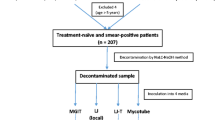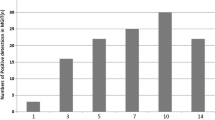Abstract
Evaluation of early bactericidal activity (EBA) by the determination of a fall in viable colony-forming units (CFU) of Mycobacterium tuberculosis in sputum is a first step in the clinical study of new antituberculosis agents. The time to detection (TTD) of growth in liquid media is more sensitive and could substitute for CFU counting on solid media. Overnight sputum samples collected during the evaluation of the novel agent TMC207 in comparison to isoniazid and rifampicin were studied. For the determination of CFU, we incubated 10-fold dilutions of homogenized sputum on selective 7H10 agar. The TTD was measured by incubating decontaminated sputum in the BACTEC MGIT 960 system. The fall in bacillary load over 7 days determined by CFU counting closely matched the prolongation of the TTD in the BACTEC MGIT 960 system. The CFU counts correlated significantly with the TTD. While the ranking of agents and different dosages of TMC207 was similar, the highest dose of TMC207 showed markedly better activity when measured by the TTD than CFU counting when compared to the activity of isoniazid. Automated TTD could augment, or, in future, replace, CFU counting to determine sputum bacillary load in EBA clinical trials pending a more formal evaluation of the correlation of the measurements.


Similar content being viewed by others
References
Mitchison DA, Sturm WA (1997) The measurement of early bactericidal activity. In: Malin A, McAdam K (eds) Bailliere’s Clinical Infectious Diseases: Mycobacterial Diseases Part II. Bailliere Tindall, London, pp 185–206
Global Alliance for TB Drug Development (2001) Tuberculosis. Scientific blueprint for tuberculosis drug development. Tuberculosis (Edinb) 81(Suppl 1):1–52
Donald PR, Sirgel FA, Venter A, Parkin DP, Seifart HI, van de Wal BW, Maritz JS, Fourie PB (2003) Early bactericidal activity of antituberculosis agents. Expert Rev Anti Infect Ther 1:141–155
Donald PR, Diacon AH (2008) The early bactericidal activity of anti-tuberculosis drugs: a literature review. Tuberculosis (Edinb) 88(Suppl 1):S75–S83
Jindani A, Aber VR, Edwards EA, Mitchison DA (1980) The early bactericidal activity of drugs in patients with pulmonary tuberculosis. Am Rev Respir Dis 121:939–949
Somoskövi A, Magyar P (1999) Comparison of the mycobacteria growth indicator tube with MB redox, Löwenstein–Jensen, and Middlebrook 7H11 media for recovery of mycobacteria in clinical specimens. J Clin Microbiol 37:1366–1369
Pfyffer GE, Welscher HM, Kissling P, Cieslak C, Casal MJ, Gutierrez J, Rüsch-Gerdes S (1997) Comparison of the Mycobacteria Growth Indicator Tube (MGIT) with radiometric and solid culture for recovery of acid-fast bacilli. J Clin Microbiol 35:364–368
Hanna BA, Ebrahimzadeh A, Elliott LB, Morgan MA, Novak SM, Rüsch-Gerdes S, Acio M, Dunbar DF, Holmes TM, Rexer CH, Savthyakumar C, Vannier AM (1999) Multicenter evaluation of the BACTEC MGIT 960 system for recovery of mycobacteria. J Clin Microbiol 37:748–752
Epstein MD, Schluger NW, Davidow AL, Bonk S, Rom WN, Hanna B (1998) Time to detection of Mycobacterium tuberculosis in sputum culture correlates with outcome in patients receiving treatment for pulmonary tuberculosis. Chest 113:379–386
Carroll NM, Uys P, Hesseling A, Lawrence K, Pheiffer C, Salker F, Duncan K, Beyers N, van Helden PD (2008) Prediction of delayed treatment response in pulmonary tuberculosis: use of time to positivity values of Bactec cultures. Tuberculosis (Edinb) 88:624–630
Pheiffer C, Carroll NM, Beyers N, Donald P, Duncan K, Uys P, van Helden P (2008) Time to detection of Mycobacterium tuberculosis in BACTEC systems as a viable alternative to colony counting. Int J Tuberc Lung Dis 12:792–798
Andries K, Verhasselt P, Guillemont J, Göhlmann HW, Neefs JM, Winkler H, Van Gestel J, Timmerman P, Zhu M, Lee E, Williams P, de Chaffoy D, Huitric E, Hoffner S, Cambau E, Truffot-Pernot C, Lounis N, Jarlier V (2005) A diarylquinoline drug active on the ATP synthase of Mycobacterium tuberculosis. Science 307:223–227
Matteelli A, Carvalho AC, Dooley KE, Kritski A (2010) TMC207: the first compound of a new class of potent anti-tuberculosis drugs. Future Microbiol 5:849–858
Rustomjee R, Diacon AH, Allen J, Venter A, Reddy C, Patientia RF, Mthiyane TC, De Marez T, van Heeswijk R, Kerstens R, Koul A, De Beule K, Donald PR, McNeeley DF (2008) Early bactericidal activity and pharmacokinetics of the diarylquinoline TMC207 in treatment of pulmonary tuberculosis. Antimicrob Agents Chemother 52:2831–2835
Lounis N, Gevers T, Van Den Berg J, Verhaeghe T, van Heeswijk R, Andries K (2008) Prevention of drug carryover effects in studies assessing antimycobacterial efficacy of TMC207. J Clin Microbiol 46:2212–2215
Mitchison DA, Coates AR (2004) Predictive in vitro models of the sterilizing activity of anti-tuberculosis drugs. Curr Pharm Des 10:3285–3295
Dhillon J, Lowrie DB, Mitchison DA (2004) Mycobacterium tuberculosis from chronic murine infections that grows in liquid but not on solid medium. BMC Infect Dis 4:51
Peres RL, Maciel EL, Morais CG, Ribeiro FC, Vinhas SA, Pinheiro C, Dietze R, Johnson JL, Eisenach K, Palaci M (2009) Comparison of two concentrations of NALC-NaOH for decontamination of sputum for mycobacterial culture. Int J Tuberc Lung Dis 13:1572–1575
Diacon AH, Pym A, Grobusch M, Patientia R, Rustomjee R, Page-Shipp L, Pistorius C, Krause R, Bogoshi M, Churchyard G, Venter A, Allen J, Palomino JC, De Marez T, van Heeswijk RP, Lounis N, Meyvisch P, Verbeeck J, Parys W, de Beule K, Andries K, McNeeley DF (2009) The diarylquinoline TMC207 for multidrug-resistant tuberculosis. N Engl J Med 360:2397–2405
Li L, Mahan CS, Palaci M, Horter L, Loeffelholz L, Johnson JL, Dietze R, Debanne SM, Joloba ML, Okwera A, Boom WH, Eisenach KD (2010) Sputum Mycobacterium tuberculosis mRNA as a marker of bacteriologic clearance in response to antituberculosis therapy. J Clin Microbiol 48:46–51
Wallis RS, Doherty TM, Onyebujoh P, Vahedi M, Laang H, Olesen O, Parida S, Zumla A (2009) Biomarkers for tuberculosis disease activity, cure, and relapse. Lancet Infect Dis 9:162–172
Conflict of interest statement
Tibotec sponsored the study from which a subset of data is analyzed in this report [14]. DFM and KA are employees of Tibotec, the manufacturer of TMC207. All other authors have no conflict of interest to declare.
Author information
Authors and Affiliations
Corresponding author
Rights and permissions
About this article
Cite this article
Diacon, A.H., Maritz, J.S., Venter, A. et al. Time to detection of the growth of Mycobacterium tuberculosis in MGIT 960 for determining the early bactericidal activity of antituberculosis agents. Eur J Clin Microbiol Infect Dis 29, 1561–1565 (2010). https://doi.org/10.1007/s10096-010-1043-7
Received:
Accepted:
Published:
Issue Date:
DOI: https://doi.org/10.1007/s10096-010-1043-7




